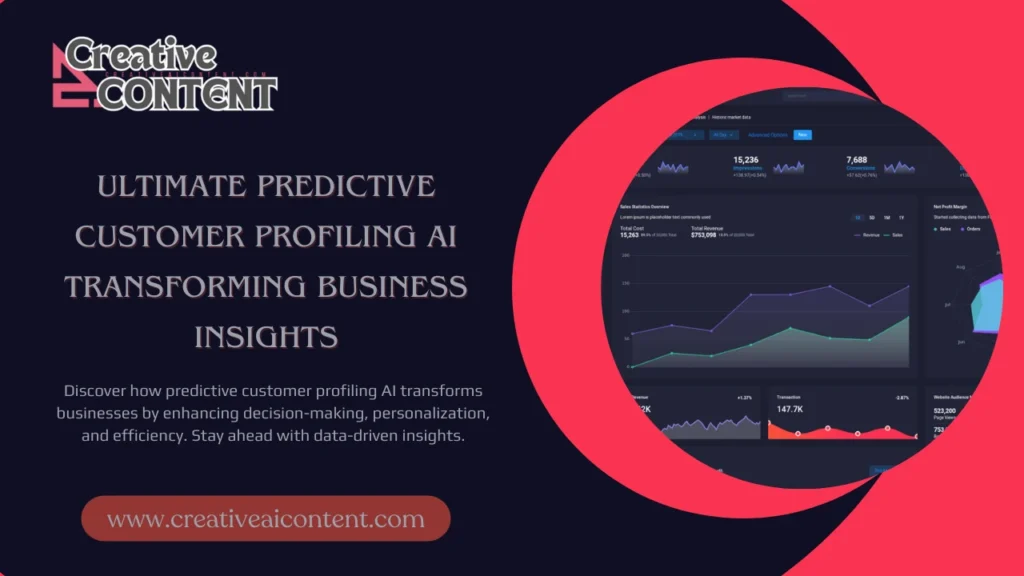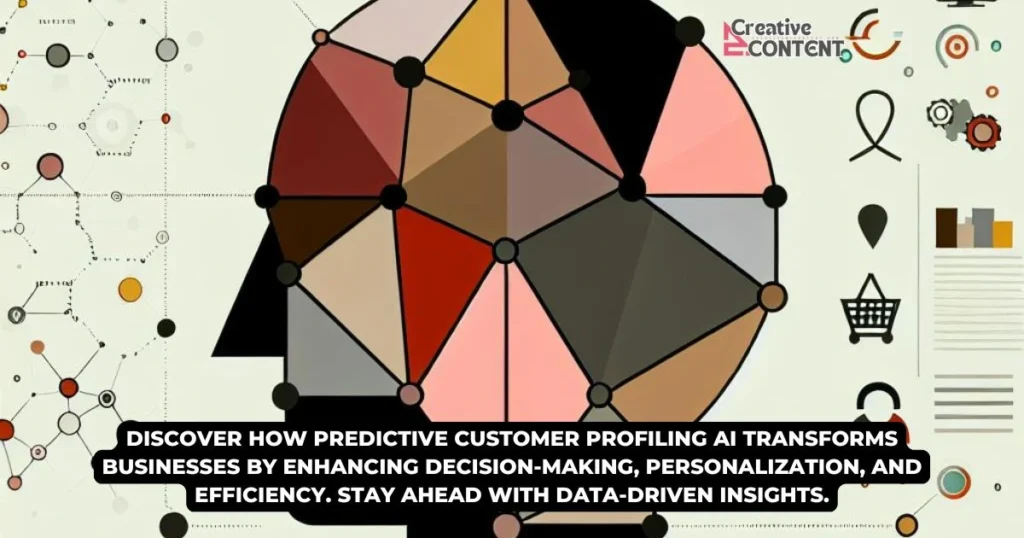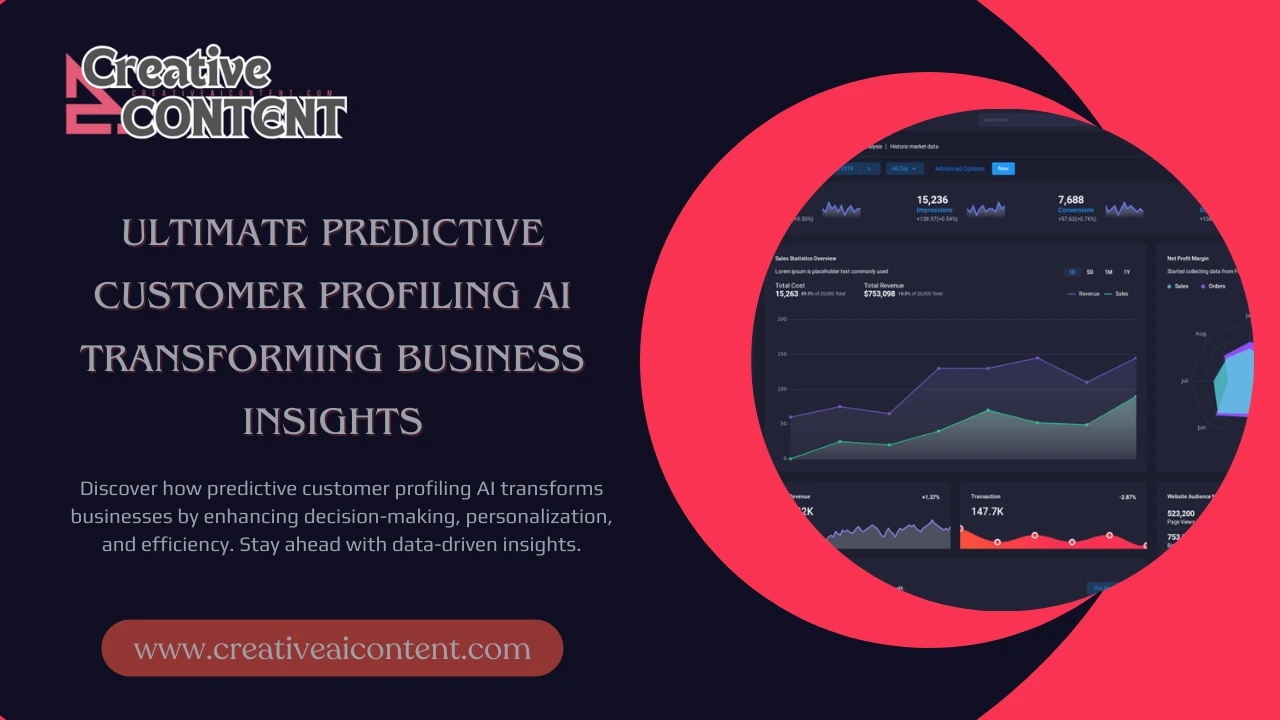In today’s data-driven business landscape, understanding customer behavior is more crucial than ever. Predictive customer profiling AI is revolutionizing the way businesses analyze data, allowing them to anticipate customer needs and optimize engagement strategies. By leveraging advanced machine learning algorithms, companies can move beyond reactive decision-making and adopt proactive approaches that enhance customer satisfaction and drive revenue growth.

This article explores how predictive customer profiling AI works, its key benefits, and its impact on modern business operations.
- What is Predictive Customer Profiling AI?
- Key Benefits of Predictive Customer Profiling AI
- The Importance of Accurate Customer Profiling
- How Predictive Customer Profiling Works
- Key Benefits of Implementing Predictive Customer Profiling
- Challenges in Predictive Customer Profiling
- Best Practices for Effective Customer Profiling
- Future Trends in Predictive Customer Profiling AI
- Real-World Applications of Predictive Customer Profiling AI
- Conclusion
- FAQs
What is Predictive Customer Profiling AI?
Predictive customer profiling AI is a groundbreaking advancement in data analytics and machine learning. This technology employs sophisticated algorithms to identify patterns within customer data, enabling businesses to anticipate future behaviors and preferences. By analyzing large datasets, businesses gain valuable insights that drive marketing strategies and customer engagement initiatives.
Key Benefits of Predictive Customer Profiling AI
- Enhanced Decision-Making
- Uses historical data to forecast customer reactions to marketing strategies.
- Helps businesses tailor their campaigns to audience preferences.
- Leads to higher conversion rates and a more personalized customer experience.
- Identifies potential high-value customers and churn risks, enabling the creation of effective retention strategies.
- Operational Efficiency
- Automates the analysis of vast datasets, freeing up resources for strategic decisions.
- Reduces manual data compilation efforts, allowing teams to focus on actionable insights.
- Increases accuracy in customer profiling, leading to more reliable business decisions.
- Proactive Business Strategies
- Transitions companies from reactive approaches to proactive strategies.
- Anticipates market trends, helping businesses stay competitive.
- Enables organizations to adapt marketing tactics based on predictive insights.
How Predictive Customer Profiling AI Drives Growth
Integrating predictive customer profiling AI into business frameworks enhances growth by:
- Offering deeper insights into customer behavior, preferences, and needs.
- Strengthening customer engagement across multiple touchpoints.
- Allowing data-driven decision-making to foster innovation and long-term success.
Predictive customer profiling AI empowers businesses to gain a competitive advantage by leveraging data-driven insights for personalized marketing, customer retention, and improved operational efficiency. As more organizations adopt this technology, the potential for strategic development and enhanced customer experiences continues to grow.
The Importance of Accurate Customer Profiling
In the contemporary business landscape, the significance of accurate customer profiling cannot be overstated. Organizations that utilize predictive customer profiling AI are empowered to make informed decisions, leading to improved strategies and operational efficiencies. Precise profiling allows businesses to understand their target audience better, tailor marketing efforts, and personalize customer experiences, which ultimately drives engagement and loyalty.
Effective customer profiling involves analyzing data points such as demographics, purchasing behavior, and preferences. By leveraging predictive analytics, companies can uncover valuable insights that inform their marketing strategies. This approach facilitates better resource allocation, ensuring that efforts are concentrated where they will yield the highest returns. When businesses understand customer needs and trends, they can develop products and services that resonate with their audience, enhancing competitiveness in the market.
Failing to prioritize customer insights can have severe consequences. Organizations that neglect accurate profiling may find themselves operating under assumptions rather than data-driven realities, which can lead to misallocated resources and missed opportunities. In a rapidly evolving market, where consumer preferences change swiftly, staying ahead of the curve is essential. By adopting predictive customer profiling AI, businesses can effectively adapt to these changes, maintaining relevance and fostering innovation. Moreover, companies who ignore the importance of accurate customer profiling risk alienating potential customers, as they may not effectively communicate or reach the right audience.
In conclusion, accurate customer profiling is a critical component of business success in today’s dynamic environment. Employing predictive customer profiling AI not only aids in better decision-making and resource allocation but also establishes a robust foundation for long-term growth and customer satisfaction.
How Predictive Customer Profiling Works
Predictive customer profiling AI employs advanced technologies to transform raw customer data into actionable insights. At the heart of this process lies data mining, a technique that facilitates the extraction of patterns from large datasets. Data mining techniques can identify trends and relationships within customer data, allowing businesses to understand their customers on a deeper level. By sifting through data points, companies gain insights into purchasing behaviors, preferences, and potential future actions.
Machine learning algorithms play a crucial role in predictive customer profiling. These algorithms utilize statistical techniques to learn from historical data and make predictions based on identified patterns. When integrated with customer data, machine learning models can analyze vast amounts of information swiftly, allowing for real-time decision-making and personalization. The algorithms adjust and refine their predictions as they are exposed to new data, continuing to enhance their accuracy and reliability over time.
The process of creating a predictive customer profiling system typically involves several essential steps. First, businesses must collect and clean their customer data to ensure accuracy and completeness. Once cleaned, the data can be analyzed using data mining techniques to determine significant patterns and trends. Following the analysis, machine learning models can be developed, trained on historical data to predict future behaviors effectively.
After developing the predictive models, integration into existing business operations is key. This may involve incorporating the insights gained into marketing strategies, customer relationship management systems, or product development initiatives. Continuous monitoring and improvement of the models and their predictive capabilities are critical to maintaining relevance in understanding customer behavior. By leveraging predictive customer profiling AI, businesses are empowered to make data-driven decisions that can enhance customer satisfaction and drive growth.
Key Benefits of Implementing Predictive Customer Profiling
Implementing predictive customer profiling AI can significantly enhance business operations and drive meaningful customer engagement. Below are the major benefits businesses can achieve by adopting this technology:
1. Increased Customer Retention
By utilizing advanced data analytics and machine learning techniques, businesses can anticipate customer needs and preferences, leading to more tailored interactions.
- Example: A prominent retail brand that employed predictive customer profiling witnessed a 25% increase in repeat purchases within a year.
- Impact: Understanding customer behavior enables businesses to build long-term relationships and foster loyalty.
2. Improved Marketing ROI
Predictive customer profiling AI allows businesses to allocate marketing resources more effectively by identifying high-potential segments that are likely to convert.
- Example: A well-known e-commerce platform implemented tailored marketing campaigns based on predictive analytics and achieved a 40% uplift in conversion rates.
- Impact: Targeting the right audience leads to better marketing effectiveness and increased revenue.
3. Enhanced Personalized Customer Experiences
Organizations can offer individualized product recommendations, special offers, and tailored content, improving customer satisfaction and loyalty.
- Example: A leading streaming service used predictive profiling to analyze viewing patterns, resulting in a more engaging user experience and reduced subscription attrition rates.
- Impact: Personalized experiences create higher customer engagement and brand loyalty.
4. Competitive Advantage
Businesses that leverage predictive customer profiling AI gain a strategic edge in the market by proactively responding to trends and evolving customer demands.
- Example: A financial services firm that integrated predictive analytics into its customer service approach saw a significant improvement in customer satisfaction ratings, establishing itself as an industry leader.
- Impact: Companies can stay ahead of the competition by making informed, data-driven decisions.

Challenges in Predictive Customer Profiling
As businesses increasingly adopt predictive customer profiling AI to enhance their decision-making processes, they encounter several challenges that can impede successful implementation. One major concern revolves around data privacy. Organizations must navigate stringent regulations, such as GDPR and CCPA, that govern the use of personal information. Protecting customer data while using AI to derive insights is not just a legal requirement; it is essential for maintaining customer trust. Failure to address privacy concerns can lead to reputational damage and legal consequences.
Quality data is another critical factor in the efficacy of predictive customer profiling AI. For machine learning algorithms to produce accurate predictions, they require large volumes of high-quality data. However, many organizations struggle with data accuracy, completeness, and consistency. Poor data quality can skew insights, rendering the predictive models ineffective. Hence, businesses need to implement robust data management practices, including regular audits and cleansing processes, to ensure that the information fed into AI systems is reliable and actionable.
The complexity of integrating predictive customer profiling AI into existing technological infrastructures presents additional challenges. Organizations often use disparate systems that may not easily communicate with one another. This fragmentation can hinder the seamless flow of data necessary for effective profiling. To overcome this, businesses should consider adopting unified platforms or ensuring that their existing systems are compatible with new AI solutions, fostering a more cohesive technological ecosystem.
Lastly, organizations frequently encounter skills shortages in their workforce. The demand for professionals skilled in AI and data analytics outpaces the supply, leaving many businesses without the expertise needed to harness predictive customer profiling effectively. Investing in training programs and hiring specialized talent can help bridge this gap, allowing businesses to fully capitalize on the advantages offered by predictive customer profiling AI.
Best Practices for Effective Customer Profiling
Implementing effective customer profiling strategies is crucial for organizations aiming to leverage predictive customer profiling AI successfully. A foundational aspect of this process is ensuring data quality. High-quality data enables the AI system to understand customer behaviors accurately and segment them effectively, leading to more precise predictions. Organizations should invest in data cleansing techniques to eliminate inaccuracies and maintain up-to-date records of customer interactions. This also involves integrating data from multiple sources to create a comprehensive view of the customer.
Another best practice is the continuous updating of customer profiles. The landscape of consumer preferences and behaviors evolves rapidly; thus, organizations must adapt their profiling approaches accordingly. Utilizing mechanisms such as regular feedback loops and behavioral analytics can provide insights into the changing needs and interests of customers. Employing predictive analytics in this context allows businesses to anticipate shifts in customer expectations, enabling them to tailor their offerings proactively.
Customer feedback is a valuable asset that should not be overlooked. Actively seeking out and utilizing customer insights can significantly enhance predictive customer profiling AI strategies. By engaging customers through surveys, social media, or direct interactions, organizations can gather critical information about their preferences and satisfaction levels. This firsthand data can then be integrated into customer profiles, offering a more nuanced understanding of the target market.
Finally, fostering a culture of data-driven decision-making within the organization is essential for maximizing the benefits of customer profiling initiatives. By training staff on the importance of data accuracy and the insights derived from predictive analytics, organizations can cultivate an environment that prioritizes informed decisions. This cultural shift promotes collaborative efforts across departments, enabling a more effective approach in leveraging predictive customer profiling AI for business growth.
Future Trends in Predictive Customer Profiling AI
As the landscape of technology continues to evolve, predictive customer profiling AI is expected to undergo significant advancements, fundamentally transforming how businesses engage with their customers. One notable trend is the integration of deep learning technologies. This method enhances data processing capabilities, allowing for more nuanced insights that enable companies to predict customer preferences and behaviors with greater accuracy. By analyzing vast amounts of unstructured data, businesses can garner actionable insights that facilitate targeted marketing efforts and product offerings.
Another emerging trend is the emphasis on personalization techniques. As consumers become increasingly accustomed to tailored experiences, businesses are compelled to refine their predictive customer profiling AI systems. Enhanced personalization means not only delivering recommendations based on past purchases but also understanding the broader context of customer needs and preferences. This deeper level of engagement can significantly improve customer satisfaction and loyalty, setting businesses apart in competitive markets.
Furthermore, the growing importance of ethical AI cannot be overlooked. As businesses leverage predictive customer profiling AI to gather and analyze data, it is crucial to ensure that these practices align with ethical standards, particularly regarding privacy and data security. Customers are increasingly aware of how their data is used, and maintaining trust is imperative for sustaining long-term relationships. Companies that prioritize transparency and ethical considerations in their AI strategies will likely see favorable outcomes in customer retention and brand reputation.
In conclusion, the future of predictive customer profiling AI is marked by significant advancements, including the integration of deep learning technologies, enhanced personalization techniques, and a commitment to ethical AI practices. By embracing these trends, businesses can foster stronger customer relationships and more effective strategies, ultimately driving growth and success in an ever-evolving marketplace.
Real-World Applications of Predictive Customer Profiling AI
Predictive customer profiling AI has become a transformative tool across various industries, leveraging data-driven insights to enhance decision-making and customer interactions. This technology enables businesses to predict customer behavior, personalize experiences, and optimize operations effectively.
1. E-Commerce Industry
Companies like Amazon have successfully implemented predictive customer profiling AI to analyze customer behavior and preferences, leading to highly personalized shopping experiences. Key benefits include:
- Product Recommendations: Advanced algorithms predict products that align with individual customer preferences.
- Higher Conversion Rates: Data-driven insights help in improving conversion rates and boosting customer satisfaction.
- Enhanced Sales Performance: Personalized recommendations contribute to revenue growth and customer retention.
Learn how Amazon uses AI to analyze customer behavior and personalize shopping experiences. How Amazon Uses AI
2. Retail Industry
Retail giants such as Walmart utilize predictive AI to optimize inventory management and sales strategies. By analyzing historical data and external factors, they achieve:
- Better Stock Management: Forecasting demand based on local events and seasonal trends.
- Reduction of Overstock Issues: Ensuring optimal stock levels to prevent waste and loss.
- Profit Optimization: Efficient allocation of resources to maximize revenue.
3. Finance Sector
Financial institutions, including banks and credit companies, employ predictive customer profiling AI to enhance security and improve customer services. This includes:
- Fraud Detection: Identifying fraudulent activities through behavioral pattern analysis.
- Personalized Financial Advice: Tailoring financial services based on spending habits and preferences.
- Customer Segmentation: Offering tailored products to different customer risk levels, increasing loyalty and satisfaction.
4. Healthcare Industry
In healthcare, predictive AI plays a critical role in early detection and personalized treatment plans by analyzing patient data. Advantages include:
- Risk Identification: Detecting patients at higher risk for specific medical conditions.
- Personalized Care Plans: Developing targeted interventions based on predictive insights.
- Improved Health Outcomes: Enabling proactive healthcare management to reduce hospital readmissions.
Predictive customer profiling AI is revolutionizing industries by providing actionable insights that drive efficiency, personalization, and profitability. Whether in e-commerce, retail, finance, or healthcare, businesses can harness this technology to optimize operations and enhance customer engagement.
Conclusion
In the rapidly evolving digital landscape, businesses are increasingly recognizing the pivotal role of predictive customer profiling AI in shaping their strategic approaches. This innovative technology enables companies to harness vast amounts of data to gain insights into customer behavior and preferences. By leveraging predictive analytics, businesses can tailor their marketing efforts, optimize customer engagement, and ultimately drive sales growth. The enhancement of customer experience through predictive profiling is not merely a trend; it has become essential for staying competitive in today’s market.
Throughout this discussion, we have explored the various advantages that predictive customer profiling AI brings to organizations. From improved target segmentation to personalized marketing strategies, the ability to forecast customer needs allows businesses to respond proactively rather than reactively. Additionally, the integration of such AI systems leads to more efficient resource allocation and higher return on investment, demonstrating clear financial benefits.
As organizations continue to navigate the complexities of digital transformation, embracing predictive customer profiling AI will be critical for those aiming to sustain and enhance their market positions. It is an invaluable tool for not only understanding the current landscape but also anticipating future trends. Therefore, we encourage businesses to invest in solutions that incorporate these advanced analytical capabilities, ensuring they are well-prepared to meet the evolving expectations of their clientele.
We invite you to join the conversation. Share your thoughts or experiences regarding predictive customer profiling AI in the comments below. How has this technology impacted your business strategies? Your insights can contribute significantly to the ongoing dialogue about the future of customer engagement and analytics in the digital age.
FAQs
Predictive customer profiling AI is an emerging technology that businesses leverage to optimize their marketing strategies and enhance customer experiences. Below are some frequently asked questions regarding this advanced tool.
